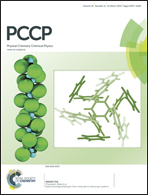Reaction-induced phase separation in a bisphenol A-aniline benzoxazine–N,N′-(2,2,4-trimethylhexane-1,6-diyl)bis(maleimide)–imidazole blend: the effect of changing the concentration on morphology†
Abstract
The effect of the concentration changes on morphology was researched by modulating the molar ratio of bisphenol A-aniline benzoxazine (BA-a) and N,N′-(2,2,4-trimethylhexane-1,6-diyl)bis(maleimide) (TBMI); the relationships between the concentration changes, the curing rate, rheological properties, and morphologies of blends were examined in this paper. The cured blends showed different morphologies at different concentrations, and the morphologies changed from a sea-island structure to a bi-continuous structure followed by a homogeneous structure when the molar ratio of BA-a was decreased. This effect was caused by the relative rates of the phase separation and the curing reaction. Meanwhile, from the thermodynamic calculations, it was found that the concentration changes altered the Gibbs free energy, while the miscibility of blends improved after decreasing the BA-a content. Moreover, from the analysis and the Flory–Huggins equation, it was found that the phase separation of BA-a–TBMI–imidazole occurred due to the molecular weights of the components and the large discrepancy between those weights.


 Please wait while we load your content...
Please wait while we load your content...